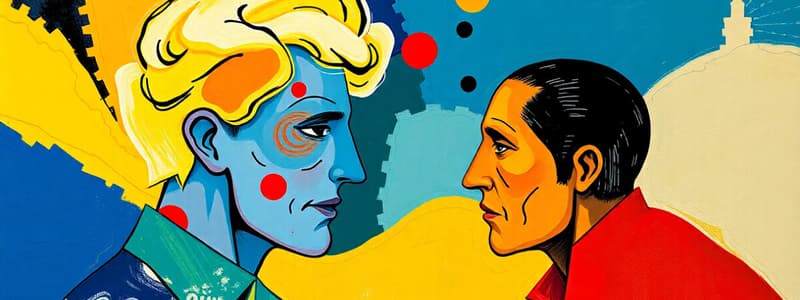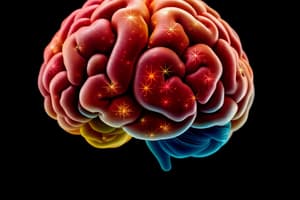Podcast
Questions and Answers
What is decision making?
What is decision making?
Decision making is a systematic process that involves defining problems, gathering information, generating alternatives, and selecting a course of action.
Which condition for decision making occurs when decision-makers have complete information and predictable outcomes?
Which condition for decision making occurs when decision-makers have complete information and predictable outcomes?
- Certainty (correct)
- Uncertainty
- Risk
- Ambiguity
Describe the condition of Uncertainty in decision making.
Describe the condition of Uncertainty in decision making.
Uncertainty is the opposite of certainty, where decision-makers lack complete information about a problem or its possible solutions.
What does the condition of Risk involve in decision making?
What does the condition of Risk involve in decision making?
Which type of decision involves standard choices made in response to well-defined and common problems, often following established rules?
Which type of decision involves standard choices made in response to well-defined and common problems, often following established rules?
What are Adaptive Decisions?
What are Adaptive Decisions?
When are Innovative Decisions typically made?
When are Innovative Decisions typically made?
Which decision-making model follows a structured, seven-step approach to increase the likelihood of solving a problem effectively?
Which decision-making model follows a structured, seven-step approach to increase the likelihood of solving a problem effectively?
What does the Bounded Rationality Model acknowledge about decision-making?
What does the Bounded Rationality Model acknowledge about decision-making?
How does the Political Model describe decision-making?
How does the Political Model describe decision-making?
What type of knowledge consists of documented information within an organization?
What type of knowledge consists of documented information within an organization?
Define Tacit Knowledge in the context of knowledge management.
Define Tacit Knowledge in the context of knowledge management.
What is Extrapolation in forecasting?
What is Extrapolation in forecasting?
Match the forecasting method with its description:
Match the forecasting method with its description:
What is Benchmarking?
What is Benchmarking?
What are the four stages of the Deming Cycle (PDCA)?
What are the four stages of the Deming Cycle (PDCA)?
What principle does Pareto Analysis use?
What principle does Pareto Analysis use?
What is another name for the Fishbone Diagram, and what is its purpose?
What is another name for the Fishbone Diagram, and what is its purpose?
What is organizational structure?
What is organizational structure?
What is organizational design?
What is organizational design?
What is Specialization in organizational structure?
What is Specialization in organizational structure?
What does Standardization ensure in an organization?
What does Standardization ensure in an organization?
What is Coordination in the context of organizational structure?
What is Coordination in the context of organizational structure?
Which coordination principle states that each employee should report to only one supervisor?
Which coordination principle states that each employee should report to only one supervisor?
What is the Scalar Principle?
What is the Scalar Principle?
Define Span of Control.
Define Span of Control.
What is Authority in an organization?
What is Authority in an organization?
Match the concepts related to Authority:
Match the concepts related to Authority:
Distinguish between Line Authority and Staff Authority.
Distinguish between Line Authority and Staff Authority.
What is Centralization?
What is Centralization?
What is Decentralization?
What is Decentralization?
Organizational design should be determined independently of the organization's strategy.
Organizational design should be determined independently of the organization's strategy.
What is the purpose of an organizational chart?
What is the purpose of an organizational chart?
What is Departmentalization?
What is Departmentalization?
Match the departmentalization method with its description:
Match the departmentalization method with its description:
There is one universally superior method of departmentalization for all organizations.
There is one universally superior method of departmentalization for all organizations.
Flashcards
Decision Making
Decision Making
A systematic process of defining problems, gathering information, generating alternatives, and selecting a course of action.
Certainty (in Decision Making)
Certainty (in Decision Making)
Decision-makers have complete information and predictable outcomes.
Uncertainty (in Decision Making)
Uncertainty (in Decision Making)
Decision-makers lack complete information about a problem or its solutions.
Risk (in Decision Making)
Risk (in Decision Making)
Signup and view all the flashcards
Routine Decisions
Routine Decisions
Signup and view all the flashcards
Adaptive Decisions
Adaptive Decisions
Signup and view all the flashcards
Innovative Decisions
Innovative Decisions
Signup and view all the flashcards
The Rational Model
The Rational Model
Signup and view all the flashcards
Bounded Rationality Model
Bounded Rationality Model
Signup and view all the flashcards
The Political Model
The Political Model
Signup and view all the flashcards
Knowledge Management
Knowledge Management
Signup and view all the flashcards
Extrapolation
Extrapolation
Signup and view all the flashcards
Scenarios (Forecasting)
Scenarios (Forecasting)
Signup and view all the flashcards
Delphi Technique
Delphi Technique
Signup and view all the flashcards
Simulation (Forecasting)
Simulation (Forecasting)
Signup and view all the flashcards
Benchmarking
Benchmarking
Signup and view all the flashcards
The Deming Cycle (PDCA)
The Deming Cycle (PDCA)
Signup and view all the flashcards
Pareto Analysis
Pareto Analysis
Signup and view all the flashcards
Fishbone Diagram
Fishbone Diagram
Signup and view all the flashcards
Specialization
Specialization
Signup and view all the flashcards
Study Notes
- Decision making is a systematic process of defining problems, gathering information, generating alternatives, and selecting a course of action
- The nature of the problem affects the solutions and risk levels in decision making
- Environmental forces play a role in determining the conditions for decisions
Conditions for Decision-Making
- Decisions occur under conditions that influence solutions and risks
- Certainty exists when decision-makers have complete information and predictable outcomes
- Uncertainty occurs when decision-makers lack complete information
- Risk is when the problem is defined and probabilities can be estimated, requiring risk assessment
Types of Decisions
- Decisions vary based on conditions, falling into three categories
- Routine Decisions involve standard choices for well-defined problems, using established rules
- Adaptive Decisions respond to unusual problems by modifying past routines
- Innovative Decisions occur when problems lack definite solutions, relying on experience and strategy
Role of Goals in Decision Making
- Decisions aim to achieve, revise, or eliminate organizational goals
- Goals give employees, managers, and organizations direction and purpose
- Decision-making aligns with the nature and evolution of organizational goals
Decision-Making Models
- Managers use models to optimize decision-making
- The Rational Model uses a structured approach to increase problem-solving likelihood
- Steps include defining the problem, setting goals, searching for solutions, evaluation, choosing the best, implementing, and following up
- The Bounded Rationality Model recognizes limitations and biases in decision-making
- The Political Model describes decision-making based on stakeholder interests and power dynamics
Knowledge Management and Decision Making
- Knowledge management is essential, involving creation, measurement, distribution, and integration of knowledge
- It includes managing intellectual assets and ensuring information sharing
- Explicit Knowledge is documented information
- Tacit Knowledge is personal insights and experiences
- Enabling Technologies are tools that facilitate knowledge sharing
Forecasting in Decision Making
- Forecasting helps anticipate conditions for informed decisions
- Extrapolation extends past trends into the future
- Scenarios are written descriptions of future events
- Delphi Technique is a consensus approach using expert opinions
- Simulation uses models to represent real systems for analysis
- Creativity enhances forecasting
Quality in Decision Making
- Quality decision-making helps meet expectations
- Benchmarking compares an organization to industry leaders to identify best practices
- The Deming Cycle (PDCA) includes:
- Plan: analyze the situation/develop plans
- Do: test solutions
- Check: evaluate implemented changes
- Act: implement the final solutions based on evaluation
- Pareto Analysis identifies the most significant causes of problems using the 80/20 principle
- Fishbone Diagrams identify root causes by categorizing problems
Organizational Structure
- The fundamental process that impacts an organizations success
- Conditions, decision types and models, enhance managerial effectiveness
- Knowledge management, forcasting and quality improvements lead to superior outcomes
- Organizational structure is critical for strategy, influencing goal achievement
- It's the formal arrangement of jobs; changing it is organizational design
- Organizational structure separates and integrates tasks, clarifying responsibilities while ensuring coordination
- A well-structured organization allows employees to collaborate effectively
Organization in Organization
- This involves coordinating activities and allocating work for organizational goals
Key Elements of Organizational Structure
Specialization
- This divides into smaller jobs for people with certain skills to increase effeciency
Standardization
- This process ensures consistent procedures via rules and regulations to ensure consistancy
Coordination
- This involves using formal and informal procedures to syncronize activities to meet objectives
- Essential qualities including:
- Managerial sensitivity
- Willingness to share responsibility
- Interpersonal communication
Principles of Coordination
- Unity of Command: Each employee reports to one supervisor
- Scalar Principle: Clear hierarchy ensures authority flow
- Span of Control: Limits subordinates per manager for efficiency
Authority
- Authority is making decisions and carrying them out
- Elements of responsibility, acountability and delegation are involved
- Line authority gives direct control
- Staff authority provide advisory roles without command
Centralization and Decentralization
- Centralization concentrates decisions at the top while decentralization distributes power
Organizational Design
- Involves structuring the organization
- It is important for supporting strategies and goals
Organizational Chart
- Visually represents an organization's structure, showing relationships and authority lines
Departmentalization
- This organizes jobs to achive organizational goals
- Departmentalization involves the division of work into specialized groups and setting performace expectations
Departmentalization Structures
- Function: organised via skillsets like (marketing, finance, HR)
- Product or Service: each product line is managed by a specialist
- Place: geographic location to allow for region specific strategies
- Customer: structure based on customers, which is usefully for service tailoring
- Network: uses external orgainzations centrally or in virtual systems
- Matrix: (functional + product) allows people to work under multiple managers to maximize skill and expertise
- There is no universal superior structure - it depends on things like strategy and circumstances of the organization
Studying That Suits You
Use AI to generate personalized quizzes and flashcards to suit your learning preferences.




